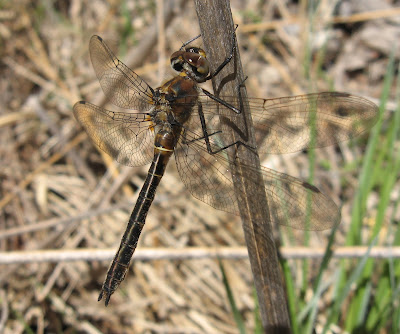Another dragonfly to add to the list of species that can be seen at the Stoco Fen ... the American Emerald (Cordulia shurtleffi). The key field marks of this species are the whitish ring between S2 and S3, and the cross-vein in the forewing triangle.
The eyes of this immature female will turn a deep green with increasing age.
A male American Emerald, encountered two years ago at Stoco Lake; this dragonfly can also be found patrolling sunlit clearings along the trail.
A lateral view of another male's terminal abdominal segements – note the forked lower clasper.
In the realm of odonate identification, the male's claspers are the final word as to species. The following images depict the claspers of a male dragonfly that at first glance appeared to be a Lancet Clubtail (Gomphus exilis). But it's difficult to separate this species from the closely related Dusky Clubtail (Gomphus spicatus) and Ashy Clubtail (Gomphus lividus) solely on the basis of body coloration and patterning. So let's have a close look at the claspers ...
When viewed in lateral profile, the upper claspers of this dragonfly bear a distinct ventral spine.
And looking at the upper claspers from above, a prominent lateral spine is visible. So our specimen isn't a Lancet Clubtail after all, these features are characteristic of the Dusky Clubtail (Gomphus spicatus). Case closed.
Three of our local Baskettails are also easily confused (there's information on how to sort them out at A Fetch of Dragonflies). But the distinctively downward bent claspers of this male are clearly visible from this angle – this is a Beaverpond Baskettail (Epitheca canis). The eyes are taking on a bluish tint with increasing age.










